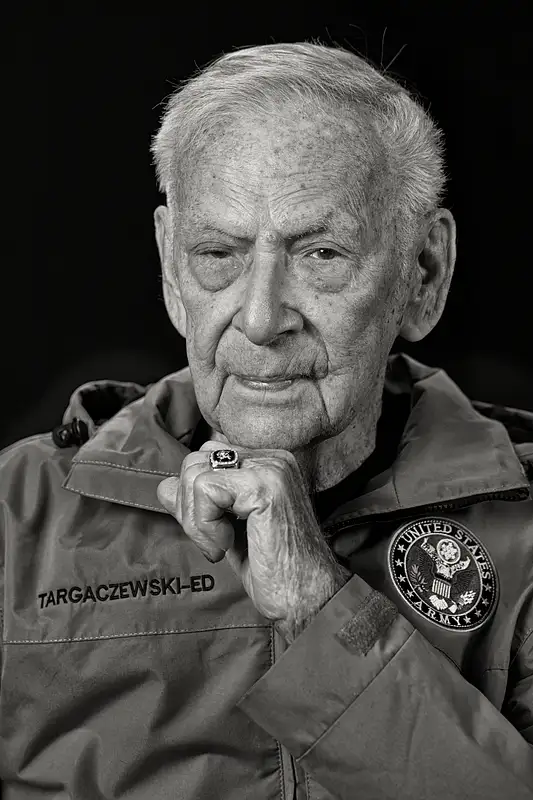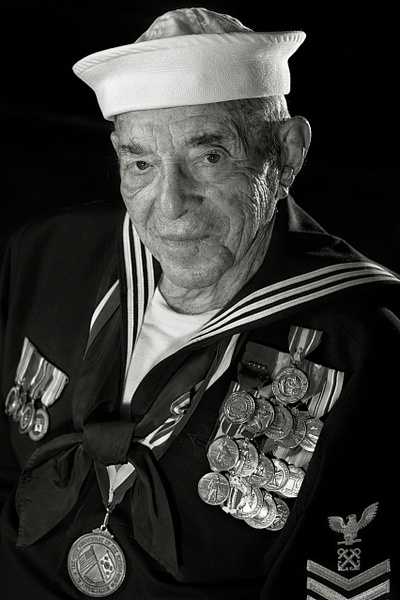Where can I donate?
I have created a way to accept donations to grow the project, use the WWII Veterans Portrait Series
Go Fund Me.
The Veterans Portrait Series.
Mickey is a retired Navy Photographers Mate, Chief Petty Officer, and was the Leading Chief of the Navy's elite Combat Camera Group Pacific. Mickey's current focus is the Veterans Portrait Series, which documents veterans' stories of service. He is focused on our Worlds' Greatest Generation. The veterans of World War II.
Mickey interviews each Veteran, collecting and writing their service stories, archiving these notable historic figures and their stories for generations to come. Mickey has collected and displayed images and stories from over 100 warriors that at one point, signed the dotted line when our country needed their sacrifice of service most. Mickey continues to collect Veterans from all services for the Veterans Portrait Series. In 2019 this body of work was displayed at the Palm Beach Photographic Centre Museum from Nov 11, 2019 — to March 1, 2020.
Mickey and the project were in the national spotlight, featured on the Sunday Today Show with Harry Smith Today Show Link to YouTube. See the Google 360 Virtual walk through from the Palm Beach Museum Exhibit. Enjoy, and thank you for your help with this project. In 2022 Mickey has photographed over 25 more WW2 Veterans and will be hosting a print show in San Diego in November with an open house on Veterans Day.
Featured Veteran

Gill Nadeau
US Navy
SM3
World War II - Korea
Born on June 4, 1926, Gilbert Nadeau enlisted in the Navy at the age of 16 with his mother’s permission. When Gil initially reported to the enlistment office, he was informed that, at four feet eleven inches tall, he fell three inches short of the enlistment height requirement. Determined to join, he made repeated visits, hoping for an exception. One day, a recruiter allowed him to take the primary exams, and subsequently, Gil was granted the opportunity to enlist.
Gil attended boot camp in Sampson, New York. On the morning of the first week of January 1944, when he arrived at boot camp, the temperature was a frigid five degrees. During his initial physical examination, he faced an unusual situation – he was below the height chart’s minimum requirement. To address this, a corpsman loaned him a uniform top, and two other corpsmen positioned him against the wall, subsequently lowering the board as a third took an ID card photo to make him appear taller than the minimum requirement. The manpower shortage during this time was evident, as Gil’s boot camp was remarkably short, spanning only 28 days, before he was shipped off to the Naval Training Center, Bainbridge, MD. He attended Signalman A School, where he graduated and achieved a meritorious promotion to Signalman Third Class in just 29 days.
After completing his training, Gil was assigned to the Naval Amphibious Base, Little Creek, VA, where he joined the amphibious training command. Their training involved using an old 158-foot wooden patrol craft with hammocks for the crew’s sleeping quarters. Subsequently, they were introduced to Landing Craft Infantry ships for transporting troops to shore during amphibious landings.
Later, Gil received orders to relocate to Portland, Oregon, where he was assigned to work on LCS-45, a Landing Craft Support ship. This ship had a crew of 75 enlisted personnel and six officers. Notably, his Commanding Officer held the rank of Lieutenant. The primary mission of the LCS was to provide support for landing troops equipped with 40mm guns and rocket systems to aid in amphibious operations.
The ship’s journey continued as it sailed to Hawaii, where the crew underwent further training. Following their training, Gil’s group of LCSs had escort duty alongside a group of LCTs on the island of Majuro. From here, they set sail to Guam and eventually reached Eniwetok. Unfortunately, during their operations at Eniwetok, the ship collided with another vessel, temporarily taking them out of action during the crucial Battle of Iwo Jima.
After repairs, the ship was reassigned to another group tasked with the final operations in the Philippine Islands. Following their successful operations in the Philippines, the ship played a role in the landings on the island of Borneo. Their contributions included assisting in securing of Brunei and later Miri, as part of the overall operations in that region.
FREQUENTLY ASKED QUESTIONS
Where are you located?
I live in the San Diego area but have traveled to many locations to interview and photograph Veterans.
How Long is an Appointment?
Appointments usually last 1 hour. But please free up time for Mickey to set up lights and cameras, hold the interview, and take some photographs for the project.
Do you accept reservations?
Yes is the simple answer to the question. Each appointment is set up as an individual session. Group sessions have been set up when I visited a senior living facility or many of the California Veterans Homes.









